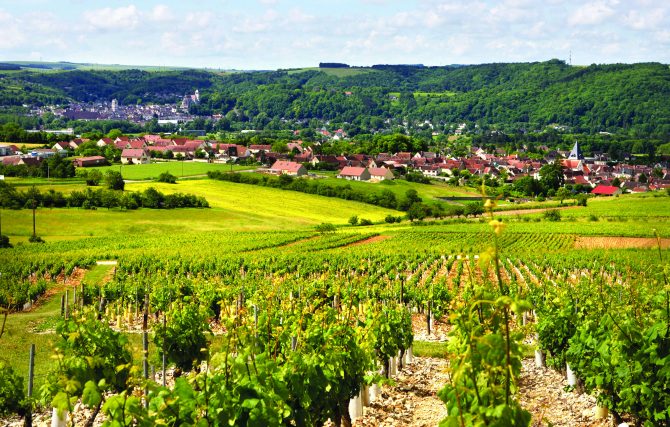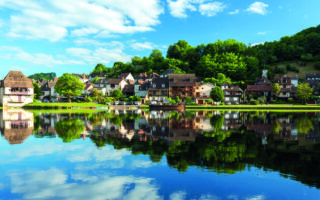Tonnerre, Burgundy: Location Guide

Go househunting in and around the town of Tonnerre in Burgundy and you’ll find historic stone homes surrounded by vineyards and waterways, says Carolyn Reynier
L’eau, la pierre, la vigne… Water, stone, vines. This is the motto of the lively woodland-surrounded little town of Tonnerre. This Petite Cité de Caractère of less than 4,500 souls is in Yonne in the Burgundy part of the Bourgogne-Franche-Comté region. It lies to the east of prefecture Auxerre and Chablis, where my grandfather owned some vines in Vaudésir, one of the seven Chablis Grand Crus.
If you prefer your white wine with bubbles, you’ll be delighted to know that Aube and the wider Champagne region are within champagne cork-popping distance. That’s the vines bit. The water is the Armançon river and Canal de Bourgogne, which run through the town. The reach (bief) surrounded the ancient town forming a protective ring for its walls. When this defensive role was no longer required, the bief was transformed to supply the watermills, giving the town its aspect of a Little Venice.
Water is also represented by the town centre Fosse Dionne, a karst (or Vauclusian) spring. Its origins date back to the 5th century BC although the source of its variable but perpetual flow remains a mystery. In 1758 it was converted into a washing place (lavoir) by the Chevalier d’Éon’s father. More of the chevalier later.
And the stone? The Hôtel-Dieu is the oldest medieval hospital in Europe. It was founded in 1293 by Marguerite de Bourgogne, countess of Tonnerre and, as if that weren’t enough, queen of Jerusalem.
The church of St-Pierre dates back to the 12th century. It was rebuilt and restored following two fires – the second, in 1556, destroyed the town. What you see today is a mélange of medieval, Italian Renaissance and 18th-century classicism. The grisaille panels, dating from 1545 and depicting the lives of Saints Peter and Paul, are one of the rare remaining examples in France. Plus there are fine medieval townhouses and an early 1900s covered market awarded a 20th-century Heritage label.

The centre-ville of Tonnerre has evolved over the centuries, says Philippe Martin, of Chevalier d’Éon Immobilier. Today, the main commercial street in the historic centre is the Rue de l’Hôpital, where old townhouses, usually without gardens or with a small one or a courtyard, have shops at street level and apartments above. Investors tend to buy up these buildings, close the shops and convert the properties into accommodation for long-term lets. You’ll also find houses, many of them with gardens, in adjacent streets.
Just outside the historic centre, another quarter was bombed during the Second World War and was then renovated in the 1950s. The houses here are less interesting from an architectural point of view. Prices vary depending on whether the property requires renovation or not.
Philippe quotes a band of €20,000 to €600,000; you should find something to suit your budget within that range. Sales of properties in the historic centre have at least doubled since Covid and its accompanying lockdowns because sellers decided to move to the countryside “to breathe a bit”, Phillippe tells me.
The interest in long-term letting is due in no small part to a new digital institute which is attracting students who often remain in the town for several years. Other renters may work in Auxerre or in the vineyards around villages like Épineuil, the other side of the canal.
Now we’ve crossed over to the eastern bank, you may be tempted to take up residence in Tanlay. This village has a Renaissance château (21m-long gallery painted in trompe l’œil and grisaille and a nine-hole golf course in its grounds) and shops, but no train.
Tonnerre has daily TER stopping trains to Dijon and Paris; the other station on that line is just south of Tanlay at Nuits-sous-Ravières. When Philippe travels to Paris he prefers a 30-minute drive south to Montbard, a Côte-d’Or sub-prefecture, to catch the high-speed TGV. “An hour later I’m in Paris Gare de Lyon, it’s great,” he says.
But I digress. Continue east from Tanlay and you come to Cruzy-le-Châtel with its pentagonal Château de Maulnes. This architectural chef d’œuvre of the French Renaissance is unique in its genre. Village houses here sell for €100,000 to €130,000, others, requiring renovation, for much less, says Philippe.
Nearby Villon, on the champagne road into the Aube department, is also popular with buyers. Philippe is selling a 150m2 village house here for €130,000.
Les Riceys, in Aube, is but a 20-minute drive away on small roads. It is the only winemaking commune in the champagne area producing all three protected appellations (AOP): champagne, Coteaux Champenois and Rosé des Riceys. Make sure your Yonne abode has a wine cellar!
Further south the Italian Renaissance château in Ancy-le-Franc has a vast ensemble of murals, rivalling Fontainebleau. Traffic has certainly increased since those days: the village is traversed by the narrow, lorry-bearing main road, Philippe tells me, which may explain why terraced houses are cheaper (€35,000-€40,000) than at Tanlay, where the golf course attracts a certain clientele.
Philippe is about to market a renovated farmstead between Laignes and Châtillon in Côte-d’Or with more than a hectare of land and priced at €320,000. A small, old renovated fermette in Aube has a pool, barn, grounds of 2,400m2 and a price tag of €161,500.
In general, you should take an average base rate of around €1,000/m2. “Then everything depends on the environment, garden and condition of the living space etc,” he explains.
You can also find properties with river or canal views. In Tonnerre you may be in a flood zone although they have unblocked a channel of the Armançon which now diverts water away when levels rise (crue, meaning flood, is the word to watch out for).
At Ravières, a four-bedroom house comes with canal view, garage, cellar, attic, and the possibility of creating separate dwellings (€128,500, ILM Immobilier). Further west, the Serein river, which runs through Chablis, also offers possibilities. At Poilly-sur-Serein, a former riverside mill converted into chambres d’hôtes is on the market at €990,000 (La Lucarne de l’Immobilier).
There are other properties in various states of repair and not far from the river both here and at Chemilly-sur-Serein and Chichée. Further south you arrive in the medieval village of Noyers-sur-Serein, one of the Plus Beaux Villages de France and popular with purchasers.

Tonnerre is part of the Petites villes de demain government action programme, which offers financial aid to help revitalise small rural towns. The man with the plan is Tonnerre’s new mayor. He wants to sell old town centre houses within the Bâtiments de France patrimony-protected perimeter at cheap prices but with the obligation on new owners to renovate their facades (with the help of subsidies) within three years.
If a town centre building has shop premises at street level, change of use will no longer be authorised – another measure to encourage reopening of high street shops. “We collaborate with the municipality because I want Tonnerre to live again, like in my childhood,” adds Philippe.
The Communauté de Communes Le Tonnerrois en Bourgogne covers 52 communes, and Philippe explains that half are not connected to mains drainage, tout-à-l’égout. Most of the private assainissements, sewage systems, no longer meet current standards. If your new home falls into this category, you have a legal requirement to bring it up to scratch within a year of purchase, at a cost of around €12,000 and €15,000.
Motorway access to the area is excellent which may be what tempted one Englishwoman to buy a property near Noyers from Dutch owners. The purchaser – in the fashion business – has offices in London and Paris. “She wanted a place in the country,” says Phillippe. “It went in eight days, for around €150,000.”
The Nitry junction for the Paris-Lyon A6 Autoroute du Soleil is nearby; north and east, this side of Aube prefecture Troyes, the A5 links south-east Paris and the Langres plateau, home to the eponymous and pungent AOP cheese.
When visitors arrive, why not serve a little Bourgogne Aligoté from Collan as an aperitif with that mouth-watering Burgundian speciality – warm gougères, small gruyère-flavoured choux buns. Or perhaps (if you’re hoping they won’t visit too often), with cold slices of Chablis andouillettes!
These large handmade sausages are made from strips of the large intestine of pig mixed with onions, herbs, and slowly cooked in a bouillon. When you’re buying, look out for the AAAAA label – L’Association amicale des amateurs d’andouillette authentique.
I first met the andouillette (and the expression espèce d’andouille, meaning idiot, numbskull) – in the champagne area where my mother-in-law would grill them on the barbecue over vine shoots. You can also heat them up in a pan or in the oven (preferably, from the aroma point of view, in someone else’s kitchen).
Oh, the Chevalier d’Éon… I almost forgot. This author, diplomat and French spy was born in Tonnerre and died in London in 1810, having spent a large part of the intervening period dressed as a woman. The word tonnerre, thunder, is also used in an expression meaning sensational, terrific – appropriate here on all counts. Tonnerre, c’est du tonnerre!
Lead photo credit : Au Fil de l'Yonne
Share to: Facebook Twitter LinkedIn Email
Leave a reply
Your email address will not be published. Required fields are marked *



